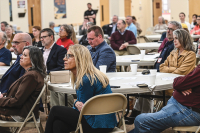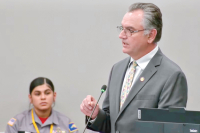One foot in the past, one in the future, Junaluskans weigh the worth of their identity
 When Ken Zulla hung up his IRS badge and retired to the well-groomed mountain hamlet of Lake Junaluska more than a decade ago, monthly sojourns to the local feed-and-seed store weren’t on the radar for his Golden Years.
When Ken Zulla hung up his IRS badge and retired to the well-groomed mountain hamlet of Lake Junaluska more than a decade ago, monthly sojourns to the local feed-and-seed store weren’t on the radar for his Golden Years.
SEE ALSO: Ongoing coverage
Merger input sought in countdown to decision
Waynesville residents will get their first chance to weigh in on the possibility of adding Lake Junaluska to the town limits with two public hearings this month.
Lake Junaluska winnows options as merger window narrows
Lake Junaluskans got their first glimpse this weekend at what it would take for the community to become its own town.
Incorporating as its own town comes with a host of regulatory, political and logistical hurdles. A task force studying the future course of Lake Junaluska residential neighborhoods heard a report on the ins-and-out of forming their own town at a public meeting Jan. 26.
Timeline for Waynesville, Lake Junaluska merger picks up speed
 Lake Junaluska and the town of Waynesville are pressing ahead with the possibility of a merger. The two entities have put the wheels in motion to introduce a special bill in the N.C. General Assembly in March that would bring Lake Junaluska into Waynesville’s town limits.
Lake Junaluska and the town of Waynesville are pressing ahead with the possibility of a merger. The two entities have put the wheels in motion to introduce a special bill in the N.C. General Assembly in March that would bring Lake Junaluska into Waynesville’s town limits.
Build it and they will come
 Back in spring of 2011 I wrote about a wetlands restoration project at Lake Junaluska - www.smokymountain news.com/archives/item/3686-a-perfect-fit. Candace Stimson, in order to fulfill her Low Impact Development degree at Haywood Community College, unearthed Suzy’s Branch behind Jones Cafeteria and created about 100 feet of free-flowing stream and wetlands.
Back in spring of 2011 I wrote about a wetlands restoration project at Lake Junaluska - www.smokymountain news.com/archives/item/3686-a-perfect-fit. Candace Stimson, in order to fulfill her Low Impact Development degree at Haywood Community College, unearthed Suzy’s Branch behind Jones Cafeteria and created about 100 feet of free-flowing stream and wetlands.
Waynesville and Lake Junaluska talk merger
 As Lake Junaluska residents chart a future course for their community, two options now remain on the table: become its own town or merge with the town of Waynesville.
As Lake Junaluska residents chart a future course for their community, two options now remain on the table: become its own town or merge with the town of Waynesville.
For decades, Lake Junaluska has operated as a well-oiled homeowners association — with its own security force, trash pick-up, water and sewer service and other amenities normally only found in actual towns.
Exploding waterfowl population prompts feeding ban at Lake Junaluska
 As the first chunk of bread was tossed in the air, a swarm of ducks and geese at Lake Junaluska swiftly waddled toward the source of the handout, a chorus of quacks and honks rising up from the flurry of feathers.
As the first chunk of bread was tossed in the air, a swarm of ducks and geese at Lake Junaluska swiftly waddled toward the source of the handout, a chorus of quacks and honks rising up from the flurry of feathers.
An authentic taste: Stuart Auditorium welcomes 42nd Smoky Mountain Folk Festival
 Mountain music, dancing and tradition will be on display once again on the shores of beautiful Lake Junaluska as the Smoky Mountain Folk Festival, now in its 42nd year, celebrates the culture and heritage of Western North Carolina.
Mountain music, dancing and tradition will be on display once again on the shores of beautiful Lake Junaluska as the Smoky Mountain Folk Festival, now in its 42nd year, celebrates the culture and heritage of Western North Carolina.
Trading autonomy for security: Lake Junaluska weighs whether to merge with town of Waynesville
 When Tom Sigmon tells people in Charlotte that he only lives there part-time, they often ask where he spends the rest of his year. Waynesville, he responds.
When Tom Sigmon tells people in Charlotte that he only lives there part-time, they often ask where he spends the rest of his year. Waynesville, he responds.
Forum to focus on Lake Junaluska’s future as a town or not
As Lake Junaluska weighs whether to become part of the town of Waynesville or form its own town, a public forum for residents to ask questions or share comments will be held at 7:30 p.m. Thursday, April 26, at Bethea Welcome Center.
At stake is Lake Junaluska’s identity and the fate of a community made up of 800 homes. A task force has been formed to study the issue. The mission of the task force includes gathering public opinion, reporting findings to the Junaluska Assembly Community Council and possibly making recommendations.
The taskforce will be made up of three representatives from the community council, three from the Lake Junaluska Assembly Property Owners Organization, three members from the community and one member representing the United Methodist Church.
While Lake Junaluska is not an official town, the community already looks and acts like one. It has its own trash pick-up, water and sewer system, street maintenance and even security force. The homes that make up Lake Junaluska’s residential community pay a yearly fee for those services.
But, an aging water and sewer system and other infrastructure issues have led the community to consider joining Waynesville instead of bearing the expense alone. If the community joins Waynesville, it would see an increase to its property-tax base but would also incur the Lake’s aging infrastructure.





